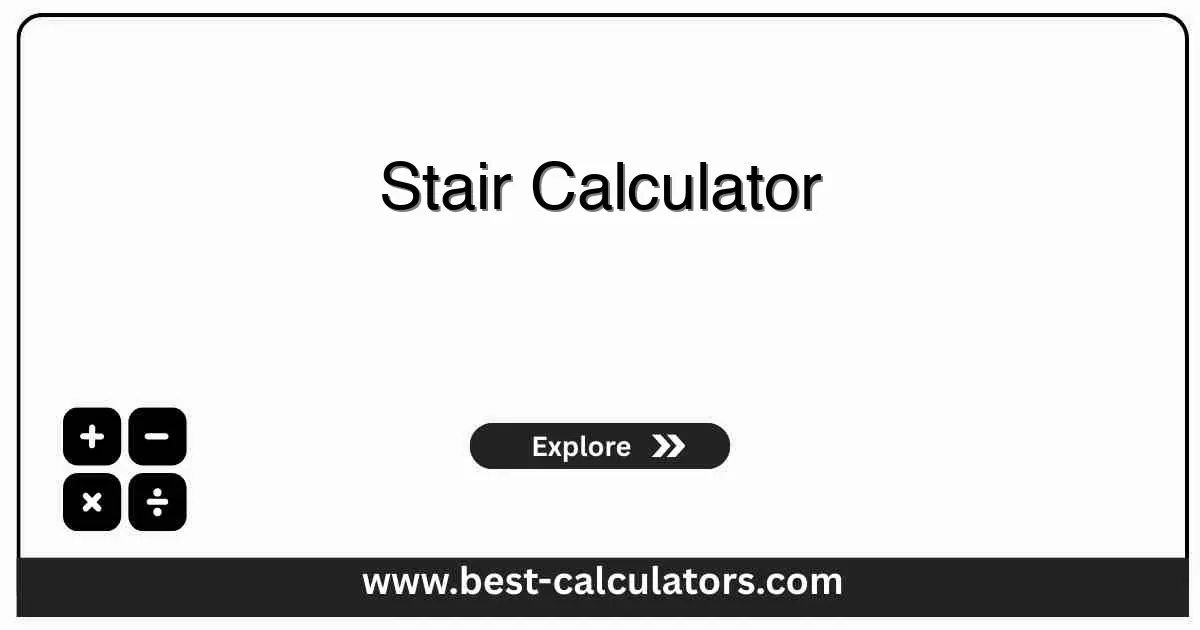Stair Calculator - Calculate Dimensions, Materials & Costs
Free stair calculator to determine riser height, tread depth, number of steps, and stringer length for safe and comfortable stair construction projects.
Stair Calculator
Results
What is a Stair Calculator?
A stair calculator is a free construction tool that helps you determine the dimensions, materials, and costs for stair construction projects. It calculates riser height, tread depth, number of steps, and stringer length for safe and comfortable stairs.
For complete construction planning, you might also need our Roof Truss Calculator for structural calculations, Snow Load Calculator for building code compliance, or Size to Weight Calculator for lumber requirements.
This calculator works for:
- New stair construction - Calculate materials for building new stairs from scratch
- Stair renovation - Estimate materials needed for stair repairs or modifications
- Code compliance - Ensure stairs meet local building code requirements for safety
- Cost estimation - Determine material costs for budgeting stair projects
- Material planning - Calculate lumber, concrete, or metal requirements accurately
Stair Calculation Process
Stair calculations involve several key steps to ensure safe and comfortable stairs:
1. Rise Measurement
Measure the total vertical height (rise) from the lower floor to the upper floor where stairs will be installed.
2. Step Calculation
Divide total rise by desired riser height to determine the number of steps needed for the staircase.
3. Dimension Adjustment
Adjust riser height and tread depth to meet building codes and ensure comfortable stair usage.
4. Material Quantities
Calculate lumber, concrete, or metal requirements based on stair dimensions and construction type.
Stair Components
Riser
The vertical portion of a step, from the top of one tread to the top of the next tread. Building codes typically limit riser height to 7.75 inches for residential stairs.
Tread
The horizontal surface of a step where you place your foot. Building codes generally require a minimum tread depth of 10 inches for residential applications.
Stringer
The structural support member that runs along the sides of the stairs, supporting the treads and risers. Typically made of wood, steel, or concrete.
Nosing
The edge of the tread that extends beyond the face of the riser below. Building codes may limit nosing projection to prevent tripping hazards.
How to Use This Stair Calculator
Enter Total Rise
Measure and input the vertical height from lower to upper floor in inches.
Specify Tread Depth
Enter desired tread depth (typically 10-11 inches for residential stairs).
Set Desired Riser
Input preferred riser height (typically 7-7.75 inches for residential stairs).
Select Materials
Choose stair type and material appropriate for your construction project.
Add Material Costs
Enter current material prices from your supplier to estimate project costs.
Benefits of Using Stair Calculator
- • Code Compliance: Ensure stairs meet local building code requirements for safety.
- • Accurate Planning: Determine exact material requirements before starting stair projects.
- • Cost Savings: Avoid over-purchasing materials and prevent costly stair shortages.
- • Project Efficiency: Plan material deliveries and construction schedules accurately.
- • Comfort & Safety: Design stairs with optimal riser/tread ratios for comfortable usage.
Factors That Affect Your Stair Requirements
1. Total Rise
The vertical height between floors directly determines the number of steps and riser height needed for your staircase.
2. Available Space
The horizontal area available affects stair configuration options and may require landing areas for turns.
3. Building Codes
Local regulations specify maximum riser height, minimum tread depth, and handrail requirements that must be met.
4. Material Type
Different materials (wood, concrete, metal) have varying costs, installation requirements, and durability characteristics.

Frequently Asked Questions (FAQ)
Q: What is the standard riser height for stairs?
A: The standard riser height for residential stairs is between 7 and 8 inches. Building codes typically require a maximum riser height of 7.75 inches for residential applications.
Q: What is the ideal tread depth for stairs?
A: The ideal tread depth for residential stairs is between 10 and 11 inches. Building codes generally require a minimum tread depth of 10 inches for residential applications.
Q: How do I calculate the number of steps needed?
A: To calculate the number of steps, divide the total rise (vertical height) by the desired riser height. Round to the nearest whole number and adjust the riser height accordingly.
Q: What factors affect stair construction costs?
A: Key cost factors include: total rise and run measurements, materials (wood, concrete, metal), stair type (straight, L-shaped, spiral), handrails and balusters, local labor rates, and permits.
Q: What is the maximum riser height allowed by building codes?
A: Most residential building codes specify a maximum riser height of 7.75 inches. Commercial applications typically have stricter requirements with maximum riser heights of 7 inches.
Q: How do I calculate the stringer length for stairs?
A: Stringer length is calculated using the Pythagorean theorem: √(total run² + total rise²). The total run is the horizontal distance covered by the stairs.